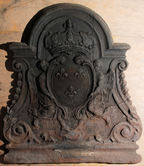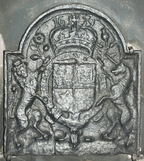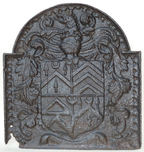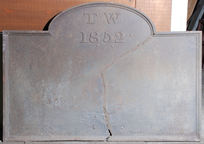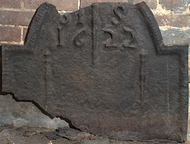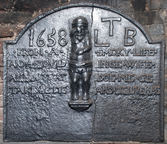-
190
Description: Arched rectangle; bevelled edge to arch and top of shoulders; initials at centre top of arch, in triangle 'S' at top; date below initials.
Notes: Possibly the work of David Robertson (1716-93), the King's Smith, whose iron grates are commonly to be found in houses designed by the prominent Scottish architects, Robert, John and James Adam, of whom he was a kinsman; the form of the plate is typical of grate-backs Robertson made in a variety of sizes, notably at Dumfries House, Ayrshire, although the lack of evidence of fixings suggest that this may have been made to be free-standing. Until 1756/7 Robertson had his forge in a tenement in Niddery's Wynd, Edinburgh, between High Street and Cow Gate, next door to John Adam's premises, although it is not known if he had a foundry there.
Inscription: S / W A / 1745
- Decoration tags:
- rectangular with round arch (shape)
- individual letters
- individual numbers
- text
Manufactured: in 1745 possibly in the Edinburgh area of Scotland.
Current location: Hill Top, Sawrey, Hawkshead, Hawkshead, Cumbria, England.
Museum number: 641831 (part of the National Trust museum group)
- Attached to series:
- Date & initials firebacks
-
191
Description: Arched rectangle; cavetto moulded edging; Tudor royal shield, Garter and crown, with crowned lion and dragon supporters; motto along bottom; Tudor rose to left of crown, portcullis to right.
Notes: This painted fireback is reputed to have been a gift from King Henry VIII to the second Sir William Godolphin, who was present at the Siege of Boulogne in 1544 with a party of Godolphin tin miners. Copies of this style of fireback were advertised in Kings Worthy Foundry's (Winchester) catalogue in the mid-20th century.
Copies of this fireback are known.
Inscription: HONI SOIT QVI MAL E PENSE / DIEU ET MON DROIT
Arms: Tudor royal (Elizabeth I)
- Decoration tags:
- rectangular with round arch (shape)
- cavetto (edging)
- whole carved pattern
- armorial
- text
Manufactured: in the mid- to late-16th century possibly in the Weald area of England.
Current location: Godolphin House, Helston, Cornwall, England.
Museum number: 169480 (part of the National Trust museum group)
- Attached to series:
- Tudor royal armorial firebacks
-
940
Description: Upon a rectangular base plinth, wide scrolled side fillets with foliage about the scrolls and suspended bell flowers in chain above; central oval shield bearing three fleurs-de-lys supported by an angel on each side, and surmounted by a French royal crown; on top, an arch rising from horizontal moulding on each side.
Notes: Characteristic of designs illustrated by architects such as Daniel Marot.
Arms: France Royal
- Decoration tags:
- rectangular with round arch (shape)
- complex individual (edging)
- whole carved pattern
- planklines
- armorial
- royal
Manufactured: in the late-17th to early-18th century in France.
Current location: not known.
- Attached to series:
- Foreign armorial firebacks
-
1075
Description: Arched rectangular shape; cavetto-moulded edging (top and sides); English Stuart Royal arms, garter, supporters, crown and motto; altered date above crown.
Notes: This design, which probably dates from 1619, has been used to cast composite firebacks with a variety of altered dates ranging from 1629 to 1662.
Copies of this fireback are known.
Inscription: 1639 [illegible Garter and royal mottoes]
Arms: English Stuart royal
- Decoration tags:
- rectangular with round arch (shape)
- cavetto (edging)
- whole carved pattern
- individual numbers
- heraldic
- armorial
- text
Manufactured: in 1639 in the Forest of Dean area of England.
Current location: Black and White House Museum, The Old House, High Town, Hereford, Herefordshire, England.
-
915
Description: Rectangular with superimposed arch; embattled, cavetto-moulded edging, with the top edge of the rectangle interrupted; quartered shield, helm, crest and mantling.
Notes: The arms appear to be those of the family of Armeston of Burbage, Leicestershire, possibly Thomas Armeston (c1606-85), 2nd son of Thomas Armeston (d.1640), sometime MP for Leicestershire: 1st and 4th (Armeston) sable a chevron between three spear heads argent with a crescent for difference, 2nd (unknown) three chevronels with a rose in a canton, 3rd (unknown) a fess between two chevronels, a crescent for difference over all. The Armeston crest is a dragon's head erased vert scaled or and charged with a crescent of the same for difference; the crescent is the mark of cadency for the second son; in this instance the arms appear to be of a second son descended from a second son in an earlier generation. The embattled edging and superimposed arch are features of a series of firebacks dated 1619. However, the style of the mantling is typical of a small group of firebacks noted in Herefordshire.
Arms: Armeston, of Burbage, Leicestershire
- Decoration tags:
- rectangular with round arch (shape)
- embattled cavetto (edging)
- whole carved pattern
- armorial
Manufactured: in the early- to mid-17th century in England.
Current location: in private hands, Honiton, Devon, England.
- Attached to series:
- Personal armorial firebacks
- Herefordshire armorial series
-
1003
Description: Large plain arched rectangular fireback with astragal edging on the top and sides.
Notes: Exceptionally large fireback, finely cast.
- Decoration tags:
- rectangular with round arch (shape)
- astragal (edging)
- whole carved pattern
Manufactured: in the late-18th to early-19th century in England.
Current location: in private hands, Horsham, West Sussex, England.
- Attached to series:
- Base boards
-
329
Description: Arched rectangular shape; simulated twisted rope edging (top & sides); central, symmetrical arrangement of a fleur-de-lys between two diamond stamps with two small cross-cut squares below, and a triad of dots outside; above, a haphazard arrangement of date, at top, above the initials, with a rose and crown to the left, and another fleur to the right.
Notes: Almost certainly an altered copy of a similar fireback dated 1613, some of the features of which have remained.
Inscription: 1637 / ILE
- Decoration tags:
- rectangular with round arch (shape)
- simulated rope (edging)
- carved stamps
- individual letters
- individual numbers
- heraldic
- text
Manufactured: in 1637 in the Weald area of England.
Current location: Horsham Museum, Causeway, Horsham, West Sussex, England.
(part of the Horsham Museum museum group)
- Attached to series:
- Diamond series
-
332
Description: Arched rectangular shape; cavetto moulded edging; top centre within arch, initials above date.
Notes: Plain elegant fireback from a late series, probably cast in the south east of England. The crack emanating from the top right corner of the fireback seems to be a weakness on all the recorded examples, and may have caused by thinness of the base board at that point.
Inscription: TW / 1852
- Decoration tags:
- rectangular with round arch (shape)
- cavetto (edging)
- individual letters
- individual numbers
- text
Manufactured: in 1852 in England.
Current location: Horsham Museum, Causeway, Horsham, West Sussex, England.
(part of the Horsham Museum museum group)
- Attached to series:
- 1850s series
-
1310
Description: Fragment; arched rectangular shape; gadrooned edging (top and sides); initials, in separate stamps, at top of arch; date probably in separate stamps, below, split by spindle; spindle used as a stamp repeated three times, one between date and initial stamps, the other two below to left and right.
Notes: Makes use of the same backing board as other firebacks in this series, and the same three spindles but with other initials; it may have originated in the Cuckfield area of Sussex, where most examples have been noted.
Inscription: SI S / 16 22
- Decoration tags:
- rectangular with round arch (shape)
- gadrooned (edging)
- simple stamps
- individual letters
- individual numbers
- text
- objects
Manufactured: in 1622 possibly at Cuckfield Furnace in the Weald area of England.
Current location: in private hands, Horsted Keynes, West Sussex, England.
- Attached to series:
- Spindle series
- Spindle/distaff firebacks
-
337
Description: Arched rectangular shaped; ovolo moulded edging (top and sides); central stamp of a carved bracket figure of a bearded man in a loincloth and cap; date and monogram in arch, split by figure, ‘T’ elevated; rhyme in capitals across centre, letters carved on strips, split by figure; date and initials as individual stamps.
Notes: The twin miseries of a smoky house and a scolding wife are mentioned several times in literature. The dress of the figure suggests work as a miner, possibly linking this back with the Forest of Dean. Variants exist without date or initials, or with other dates. A version of this fireback with the date 1660, instead of 1658, was noted at Bellamy's Farm, Longney, Gloucestershire in 1912 (Notes and Queries, 11th ser., 6 (Sep 1912), p.230.).
Copies of this fireback are known.
Inscription: 1658 LTB; ·FROM ·A·-·SMOKY ·LIFE·/ AND·A SCOVL DING·WIFE·/ALL MEN THAT-DOE·ME·SE/ TAKE·PETIE- AND·DELIVER ME
- Decoration tags:
- rectangular with round arch (shape)
- fillet (edging)
- carved stamps
- individual letters
- individual numbers
- text
- humans
Manufactured: in 1658 possibly at Tintern Furnace in the Forest of Dean area of Wales.
Current location: in private hands, Huddington, Worcestershire, England.
Citation: Chambers, L. H., 26 Sep 1912, 'Fireback: Relic of 1660', Notes and Queries, 11th series, 6, p. 230.
- Attached to series:
- Figurine firebacks
- Twin miseries series
- 1640-50s Dean series


